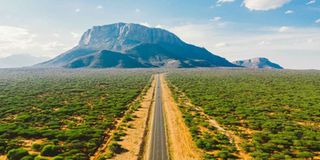The sacred mountain

Mt Ololokwe in Samburu.
What you need to know:
- Stumbling under the weight of my backpack, I found it hard to imagine how such large animals could navigate a path so steep.
- After our initial steep climb, we followed Lemaiyan into a stretch of dense forest.
- We all found a perch on the smooth rock and looked out towards Samburu.
‘Maape!’. ‘Let’s go!’. Our Samburu guide, Lemaiyan, urged us to continue our climb after a long water break. The mid-morning heat had been turned up a notch, and our progress was slow. We zigzagged up the eastern slope of Mount Ololokwe along a path well trodden by elephants and cattle.
Stumbling under the weight of my backpack, I found it hard to imagine how such large animals could navigate a path so steep.
As our route levelled out, it became clear why they are drawn to the summit. From the ground, the top half of Ololokwe seems to be just a smooth, rounded rock surface. Hence the name ‘Ololokwe’, which means ‘wide head’ in Samburu. But the head isn’t as bald as it appears from below.
Across the top there are patches of cloud forest sustained by moisture-laden air currents that swirl above the mountain. Around the forests are natural springs – near permanent sources of water for wildlife and livestock in the dry season.
I’ve been drawn to Ololokwe for some years, too. It’s a fitting symbol of Kenya’s ‘Big North’ – a vast territory of rocky outcrops, dry riverbeds and arid shrubland. There are plenty of picturesque campsites across this landscape, but none appealed to me more than those at the summit of one of its tallest mountains.
Dense forest
After our initial steep climb, we followed Lemaiyan into a stretch of dense forest. For a while we wandered beneath the canopies of tall cedar, fig and croton trees. We then came across a small tipilikwa shrub with a tower of stones stacked within a tangle of branches.
We each placed our own stone onto the pile and made a wish, as is tradition for first time visitors to this sacred mountain.
Nearby was a peculiar palm-like tree with dark green fronds and yellow corncob-shaped cones. We spotted more of them as we trekked across the summit.
My brother, Andreas, pointed out that these were Matthews Cycads, endemic to Kenya and with origins stretching back 280 million years to a time before dinosaurs. Because the montane forests in this part of country are isolated by the dry gulf that surrounds them, they have been allowed to evolve in their own direction. So these cycads are true living fossils.
Seasonal rivers
Three hours after setting off, we finally arrived at our campsite. There are two main campsites on the summit, one sheltered from the elements in the forest, and the second near the southern cliff face.
Another group had already pitched their tents in the forest so we set up camp in the open. We were more exposed here to the heat of the day, and the cold at night, but it was worth it for the view.
We all found a perch on the smooth rock and looked out towards Samburu. The straight Great North Road cut across winding seasonal rivers, and vast blotches of white and red soil.
Thermalling vultures occasionally drifted into view, and disappeared again below the edge of the cliff. From 2,000 metres up, northern Kenya really is breathtaking.
In the evening the weather shifted, and it rained for the first time in five months. Strong winds battered our tents throughout the night, and at dawn the summit was cloaked in a blanket of fog. I wandered as far as I dared to the edge, and watched a faint orange glow appear through the haze. It wasn’t the spectacular sunrise I’d hoped for, but it has definitely given me an excuse to go back.
Our hike was organised through Sabache Camp at the base of the mountain, where we stayed for the first night of our trip. They have comfortable safari tents with great views, and a well-equipped kitchen for self-catered groups.
For bookings and more information, email [email protected], or visit www.sabachecamp.com.





